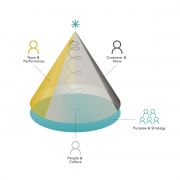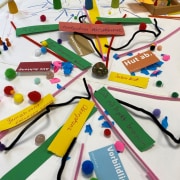Leadership to Leader-shift
25.07.2020
Things have got to change. The classic management structures no longer reflect the zeitgeist. For years now, one new management model has been chasing the next, countless “recommendations” are being made as to how an ideal manager should be “knitted” and there are also no shortages of alternative solutions at organizational level. More self-responsibility and self-efficacy is the credo. More self-leadership, in other words.
But how does leadership lead to a leader-shift?
It’s up to the executives…
Currently, in times of home office and emerging smart work, they are once again under real criticism, the managers. They cannot allow a liberalisation of the world of work. And they fear an erosion of power and influence. They do not know how to manage their team remotely. Managers simply want to have everything under control. In general, they do not trust. And the current situation makes this really clear.
So say the statements of countless articles, studies and voices of the public. And yes, this certainly applies to some managers as well.
At the moment, it is also time to break the lance for the “entire population of managers”. Many representatives I have met in my role as a coach over the past years have their hearts in the right place. And a mindset that deserves recognition. Many have approached their task with idealism and a large number of innovative ideas. They have put a lot of strength and energy into their role. Many have braced themselves against windmills. And some have also failed because of it. Or have decided to go into adaptation in order to “survive” in the system. Which is also simply human.
Or the organizations …
It is worth taking a look at this very system or organization or company. Although “purpose” and “self-organization“, “agility” and “flat hierarchies” are on everyone’s lips, we are still far from realizing these ideas. Home office – yes of course, this is the new work format that will have to be taken into account more and more in the future. And Scrum & Co – has already been implemented where it makes sense.
However, most organizations are still classically in silos organized and the executive is more the manager than the leader. He or she is measured by numbers and results. Perhaps a human-KPI will also play a role at times. One under 10. The team is just a side issue. And for the individual there is the annual meeting. Personal aspects can be discussed there. If it weren’t for these annoying employee surveys and mood barometers, everything would actually be fine.
Especially since almost all of the organization’s managers have already completed the workshop series on “New Leadership”, “Agile Methods” and not to forget “Digital Transformation”. So now, anyone should be able to lead in the zeitgeist and according to the current conditions.
And the employees…
Let’s assume that we would change this term to “co-creators”. That would make a huge difference. First of all, the term “work” per se is not really the “burner”. And secondly, the question of how “added value” will be created in companies in the future is exactly that. It Is “worked off” or “co-created”.
This is primarily a mindset question again, which then triggers consistent follow-up considerations.
If one thinks of this in “work” and thus in a Tayloristic world view, there may be good reasons for structuring, placing orders and controlling. For those concerned, this is then “annoying”, often stressful and limited but also familiar and within “9 to 5” and their own “comfort zone” (if one can speak of comfort here).
One thinks that in “creation” then everything changes. First the own inner attitude. Then you have to change to self–responsibility, self-expression and self-management. Then there is no one left to say where things go, that is taken over by oneself. And then it is presented and discussed in dialogue. Then mistakes are on the agenda and failure becomes an everyday part of your own actions. Then freedom becomes tangible. And consequence too. Then the comfort zone is shifted towards the growth zone.
From Leadership to Leader-shift
Assuming we are serious about organizational and leadership change – which is probably essential – it would be advisable to use the window of opportunity opened by COVID 19 to implement the change. Then it would make sense to consistently pursue the path we have taken toward liberalizing “work”.
However, a few essential aspects should not be overlooked. The mindset-shift must accompany the structural change. It is not enough to implement “Smart Work”. The people in the organisation should also be willing and able to act as “co-creators”. Their contribution would be to take over self-management in their professional activities and thus contribute their part to the leader-shift. This is something that first needs to be learned.
Parallel to this, managers would have the task of enabling more people to take the step out of the comfort zone and into the learning and growth zone. To trust them, to encourage them, to accompany them, to create a suitable framework, but also to demand the shift again and again. This is certainly for one or the other a sustainable change of his or her own role. And that also needs support, e.g. through coaching.
Above all, however, recognition within the own organisation. If leadership performance continues to be measured according to the classic model and only with the previous KPIs, this will not work.
Instead, there should be a clear separation between added value and results (management) and the empowerment and effectiveness of the individual (leadership).
Here, the Shared LeaderShift model is recommended as a pragmatic approach.
Leadership is needed for the change from leadership to leadership shift. On the way to an increasingly self-organizing system in which human, especially emotional and creative competence, as well as artificial intelligence co-create and shape the future.









